Memory Scaling on Haswell CPU, IGP and dGPU: DDR3-1333 to DDR3-3000 Tested with G.Skill
by Ian Cutress on September 26, 2013 4:00 PM ESTEnabling XMP with ASUS, GIGABYTE, ASRock and MSI on Z87
By default, memory should adhere to specifications set by JEDEC (formerly known as the Joint Electron Device Engineering Council). These specifications state what information should be stored in the memory EEPROM, such as manufacturer information, serial number, and other useful information. Part of this are the memory specifications for standard memory speeds, including (for DDR3) 1066 MHz, 1333 MHz and 1600 MHz, which a system will adhere to in the event of other information not being available.
An XMP, or (Intel-developed) Extreme Memory Profile, is an additional set of values stored in the EEPROM which can be detected by SPD in the BIOS. Most DRAM has space for two additional SPD profiles, sometimes referred to as an ‘enthusiast’ and an ‘extreme’ profile; however most consumer oriented modules may only have one XMP profile. The XMP profile is typically the one advertised on the memory kit – if the capability of the memory deviates in any way from specified JEDEC timings, a manufacturer must use an XMP profile.
Thus it is important that the user enables XMP! It is not plug and play!
At big computing events and gaming LANs there are plenty of enthusiasts who boast about buying the best hardware for their system. If you ask what memory they are running, then actually probe the system (by using CPU-Z), I sometimes find that the user, after buying expensive memory, has not enabled XMP! It sounds like a joke story, but this happened several times at my last iSeries LAN in the UK – people boasting about high performance memory, but because they did not enable it in the BIOS, were still running at DDR3-1333 MHz C9.
So enable XMP with your memory!
Here is how:
Step 1: Enter the BIOS
This is typically done by pressing DEL or F2 during POST/startup. Users who have enabled fast booting under Windows 8 will have to use vendor software to enable ‘Go2BIOS’ or a similar feature.
Step 2: Enable XMP
Depending on your motherboard manufacturer, this will be different. I have taken images from the major four motherboard manufacturers to show where the setting is on some of the latest Z87 motherboard models.
On the ASUS Z87-Pro, the setting is on the EZ-Mode screen. Where it says ‘XMP’ in the middle, click on this button and navigate to ‘Profile 1’:
If you do not get an EZ mode (some ROG boards go straight to advanced mode), then the option is under the AI Tweaker tab, in the AI Overclock Tuner option.
For ASRock motherboards, navigate to OC Tweaker and scroll down to the DRAM Timing Configuration. Adjust the ‘Load XMP Setting’ option to Profile 1.
For GIGABYTE motherboards, such as the Z87X-UD3H in the new HD mode, under Home -> Standard is the separate XMP setting, as shown below:
Finally on MSI motherboards, select to the OC option on the left hand side and XMP should be in front of you:
I understand that setting XMP may seem trivial to most of AnandTech’s regular readers, however for completeness (and the lack of XMP being enabled at events it seems) I wanted to include this mini-guide. Of course different BIOS versions on different motherboards may have moved the options around a little – either head to enthusiast forums, or if it is a motherboard I have reviewed, I post up all the screenshots of the BIOS I tested with as a guide.


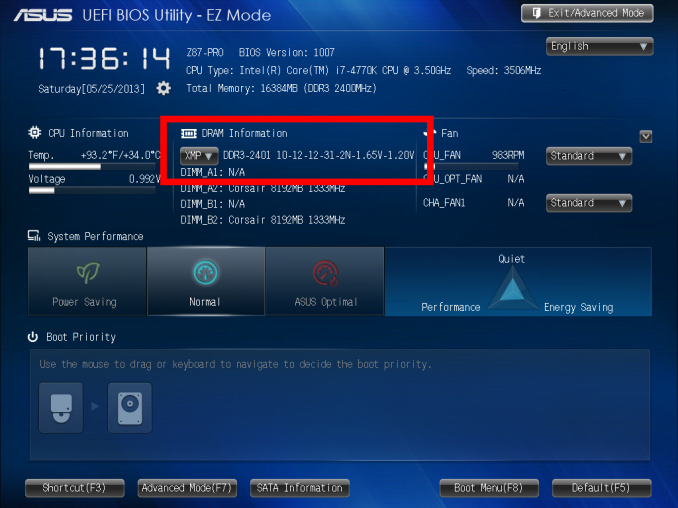
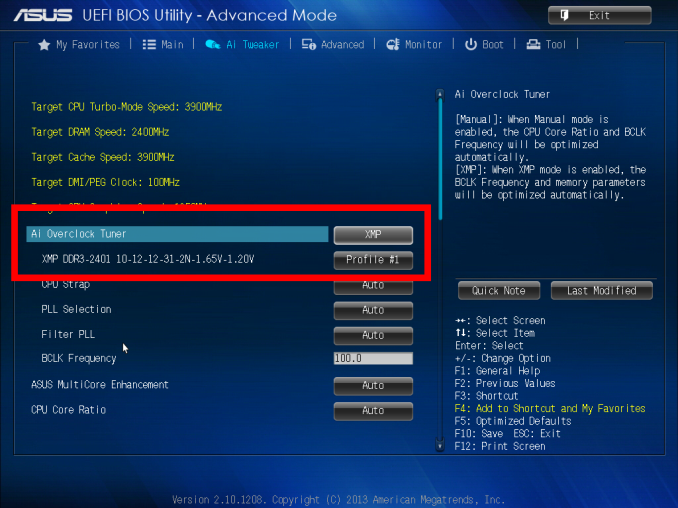
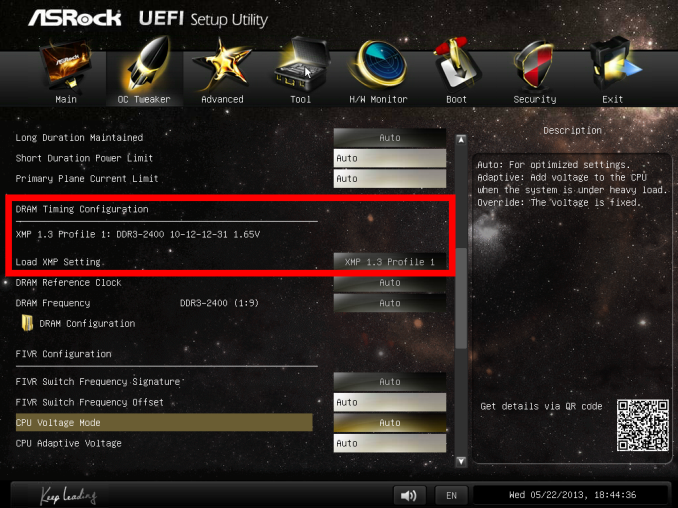
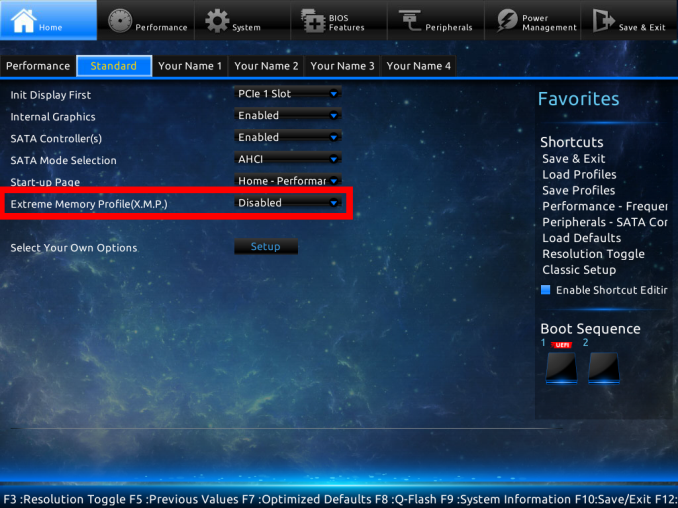
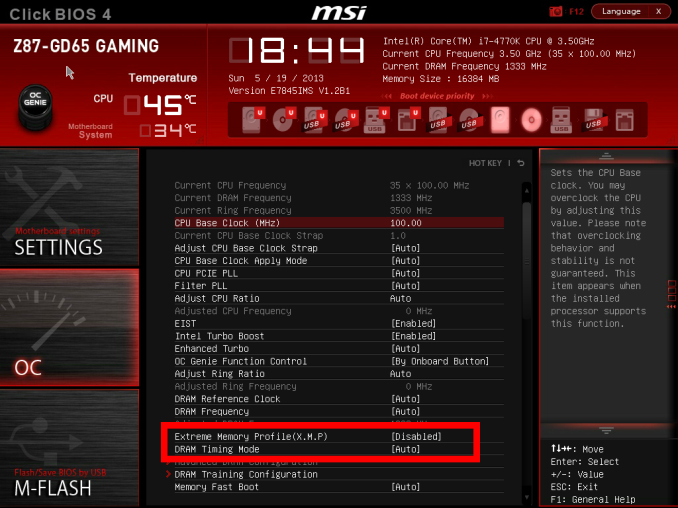








89 Comments
View All Comments
DanNeely - Thursday, September 26, 2013 - link
A suggestion for future articles of this type. If the results mostly show that really slow memory is bad but above that it doesn't really matter, normalizing data with a reasonably priced option that performs well as 1.0 might make clearer. ex for the current results put 1866-C9 as 1.0, and having 1333 as .9x and 3000 as 1.02. I think this would would help drive home that you're hitting diminishing returns on the cheap stuff.superjim - Thursday, September 26, 2013 - link
It looks like the days of 1600 C9 being the standard are over however the Hynix fire isn't helping faster memory prices any. 4-5 months ago you could get 2x 4GB of 1600 C9 for $30-35 bucks.Belial88 - Tuesday, October 1, 2013 - link
That's because just like when HDD prices skyrocketed due to the 2011 Thailand Flood, RAM prices have skyrocketed due to the 2013 Hynix Factory Fire. Prices had started to rise around early 2013 due to market consolidation and some other electronics (tablet, console, etc market needs), nothing huge, and they were actually starting to drop until the factory fire.As for 1600 C9 being some sort of standard, well, what Intel/AMD specifies as their rated RAM speed is no more useful than what they specify their CPU speed, as we know the chip can go way above that. JPeople who are savvy and know how to buy RAM, can buy RAM easily capable of 2400mhz CL8 by researching the RAM IC.
PSC/BBSE is easily capable of 2400mhz CL8 and generally costs ~$60 per 8gb (ie similar to the cheapest ddr3 ram). You can find some Hynix CFRs (double sided, unlike MFR, meaning they don't hit the high mhz numbers, but way better 24/7 performance clock for clock, kinda like dual channel vs single channel) for around $65, like the Gskill Ripjaws X 2400CL11 (currently like $75 on newegg), which will easily do ~2800mhzCL13.
RAM speed has always made an impact, the problem with reviews like the above is assuming you can't overclock RAM, and have to pay for it. In reality there is only ~5 different types of RAM (and a few subtypes). If you are smart and purchase Hynix, Samsung instead of Spektek, Qimonda, you can get RAM that easily does 2400mhz+ for the same or simliar price as the cheapest spekteks. If you assume that going from 1600 to 2400 will cost you $100+, of course it's a ripoff...
But if you buy, say, some Gskill Pi's 1600mhz for bargain bin, and overclock them to 2400CL8, you gain a good 10+ fps for almost nothing, and that's an awesome value. All RAM is just merely rebranded Spektek/Qimonda/PSC/BBSE/Hynix/Samsung, ie the same RAM is sold as 1600 CL9, 1600 CL8 1.65v, 1866 CL10, 2000CL11, 2133 CL12, etc ad nauesum.
vol7ron - Monday, September 30, 2013 - link
Relational results are helpful -I think they've been added since your comment- but I also like to see the empirical data as is also being listed.I know these things are currently being done in this article, I just want to make it a point not to make the decision to use one or the other, but both, again in the future.
vol7ron - Monday, September 30, 2013 - link
As an amendment, I want to add that the thing I would change in the future is the colors used. The spectrum should be green:good red:hazardous/bad. If you have something at 1.00x, perhaps that should be yellow, since it's the neutral starting position.alfredska - Monday, September 30, 2013 - link
Yes, this is some pretty basic stuff. It seems there's bouncing back and forth between green = good/bad right now. The author needs to stick to a convention throughout the article. I'm not really of the opinion that green and red are the best choices, but at least if a convention is used I can train my eyes.xTRICKYxx - Thursday, September 26, 2013 - link
It would be cool to see other IGP's including Iris Pro or HD 5000. Also, Richland may see slightly more than the 5% Haswell's HD 4600 has.Khenglish - Thursday, September 26, 2013 - link
I would expect richland/trinity to have larger gains since the IGP has access to only 4MB cache instead of 6MB or 8MB found on intel processors.yoki - Thursday, September 26, 2013 - link
hi, you said that the order of importance place amount of memory & their placement is most importance, but not a clue regarding how this scale in real world... for example i have 1600mhz 7Cl 6GB RAM in a x58 system,,,,should i upgrade it to 12GB ... how much i'll gain from thatIanCutress - Thursday, September 26, 2013 - link
That's ultimately up for the user to determine based on workload, gaming style, etc. I'd always suggest playing it safe, so if you plan on doing anything that would tax a system, 12gb might be a safe bet. That's X58 though, this is talking about Haswell, whose memory controller can take this high end kits ;)